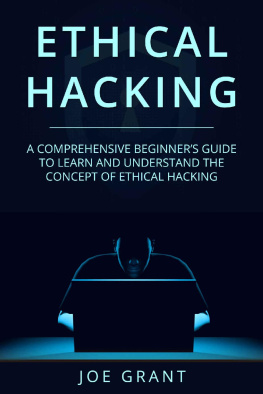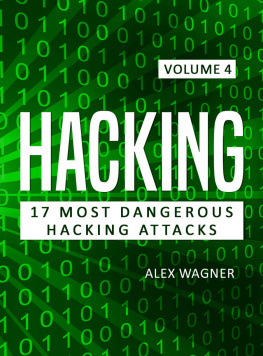Hacking AI
Big and Complete Guide to Hacking, Security, AI and Big Data.
Hans Weber
Copyright 2021 by Hans Weber - All rights reserved.
This document is geared towards providing exact and reliable information in regards to the topic and issue covered. The publication is sold with the idea that the publisher is not required to render accounting, officially permitted, or otherwise, qualified services. If advice is necessary, legal or professional, a practiced individual in the profession should be ordered.
- From a Declaration of Principles which was accepted and approved equally by a Committee of the American Bar Association and a Committee of Publishers and Associations.
In no way is it legal to reproduce, duplicate, or transmit any part of this document in either electronic means or in printed format. Recording of this publication is strictly prohibited and any storage of this document is not allowed unless with written permission from the publisher. All rights reserved.
The information provided herein is stated to be truthful and consistent, in that any liability, in terms of inattention or otherwise, by any usage or abuse of any policies, processes, or directions contained within is the solitary and utter responsibility of the recipient reader. Under no circumstances will any legal responsibility or blame be held against the publisher for any reparation, damages, or monetary loss due to the information herein, either directly or indirectly.
Respective authors own all copyrights not held by the publisher.
The information herein is offered for informational purposes solely, and is universal as so. The presentation of the information is without contract or any type of guarantee assurance.
The trademarks that are used are without any consent, and the publication of the trademark is without permission or backing by the trademark owner. All trademarks and brands within this book are for clarifying purposes only and are the owned by the owners themselves, not affiliated with this document.
Table of Contents
Hacking AI
BOOK 1 - Computer Systems and Networking Guide: A Complete Guide to the Basic Concepts in Computer Systems Networking, IP Subnetting and Network Security.
BOOK 2 - Hacking: A Quick and Simple Introduction to the Basics of Hacking, Scripting, Cybersecurity, Networking and System Penetration.
BOOK 3 - Artificial Intelligence And Life: A Complete Guide to the Basic Concepts in AI, Neural Networks, Machine Learning and Data Science.
BOOK 4 - Big Data: A Complete Guide to the Basic Concepts in Data Science, Cyber Security, Analytics and Metrics.
Computer Systems and Networking Guide
A Complete Guide to the Basic Concepts in Computer Systems Networking, IP Subnetting and Network Securi ty .
Hans Weber
Introduction
How much do you know about a computer today? Its not just about knowing the basics. Computer networking is what drives in the world today, and if you are looking for a career as a computer networking specialist, now is the time.
Computer system networks are the backbone of most companies set by today standards. Even more so, its the backbone of all major companies successful in recent times.
Anyone who can understand its importance and knows how to exploit them can safeguard their ventures from most of yesterdays issues. They provide a seamless way to keep logs, inventories, transactions, and payrolls; these networks are also the primary communications channels right now.
With this guide, youll acquire all the knowledge necessary for a first grasp on the subject. That knowledge will be the main pillar for anyone looking to implement similar networks; anyone looking to study and specialize in computer system networks will also get the best starting point for their journey.
What can you expect to understand after finishing the content inside this book?
First, youll know the most basic concepts: how these networks started, what makes them up, and how you can identify one. Through the first chapters, youll learn the fundamental knowledge about them.
Naturally, the book will deepen the knowledge as the reader continues.
After understanding the concept, youll move into the most intricate concepts necessary to set them up: IPs, subnetting, and even how to establish a good security system for keeping your network safe.
The book covers both how to set up a secure network as well as what dangers you could face when establishing your systems.
Finally, youll learn how these systems apply to different industries and company models.
In the end, the reader will know all they need to understand the necessary steps and concepts necessary to integrate and exploit these systems to their fullest.
Chapter One: An Introduction to Computer Systems and Networking
How did it start?
If we are going to start talking about computer systems and networks as a career, we have to understand its history and how it became an in-demand job today.
"Information technology," better known as IT, is defined as the technology that involves the development, use and maintenance of computer systems, software and networks for the distribution and processing of data. The term goes way back to 1978.
Computers did exist before 1978, but they were mostly used to perform calculations. Since they started to be used to index and sort written information, the term IT was invented.
Today, IT is a quickly evolving field and that, of course, includes the computer systems and networking career inside this branch.
Computer systems and networking. What exactly is it?
The IT career is based on the upkeep, configurations and reliable operation of the computer system, especially the process of multi-user computers and its networks with other users. Nowadays, companies rely on their networks for a lot of their work, so any issues must be fixed quickly and entirely.
The computer systems and network administrator keeps the organization's workflow and its lines of communication accessible - at all times necessary. Besides identifying and solving network problems, computer systems administrators also make updates to all hardware and software they manage, so they're always ongoing.
A computer systems administrator is the main point of contact for an organization's network users when they suffer some technical issues. The specialist also needs to guarantee that every connection in the office is working well and supervise the performance of the Internet optimizing their hardware and software.
A computer system and network administrator also make sure that the overall performance and security of the computers they supervise, fulfil the needs of the network users, without surpassing the company's budget.
The person in charge of this job needs to be ready to find new issues each day and needs to get their knowledge optimized to approach them efficiently.
The importance of the field in the current era
Today, companies look at networks and computer systems as their foundation to work optimally.
They need their hardware to be highly functional and maintainable, they need their Internet and servers stable, and they need someone to do all the networking and cable installation and check-ups constantly around their offices.
As we said before, they are the ones responsible for the configuration, reliable operation and upkeep of computer systems inside the office. They seek to ensure that the uptime, performance, resources and security of the computers they manage to meet the needs of all the users.
Today, companies are very dependent on this type of professionals. They need to check the performance of their systems and need a person available almost 24/7 to guarantee that everything is functioning as it should. If one of their servers are down, or they lose Internet connection, they start to lose money very quickly mainly because they stop their production for a certain amount of time, and there is no way to monetize the operation without it working efficiently with the connections and servers.











